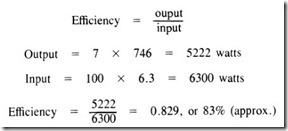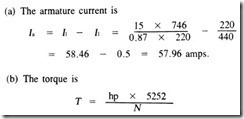Problem-A de motor requires 10kilowatts to enable it to supply its full capacity of 10 horsepower to its pulley. What is its full-load efficiency?
Solution—
Problem-A 7-hp motor takes 6.3 kilowatts at full load. What is its efficiency?
Solution—
Problem-A certain load to be driven at 1750 r/min requires a torque of 60 lb. ft. What horsepower will be required to drive the load?
Solution –
Problem-A 15-hp, 220-volt, 1800-r/min shunt motor has an effi ciency of 87 per cent at full load. The resistance of the field is 440 ohms. Calculate the
(a) Full-load armature current.
(b) Torque of the machine.
Solution-
(a) The armature current is
Problem-When the field rheostat is cut out, a 230-volt shunt motor generates a counter emf of 220 volts at no load. The resistance of the armature is 2.3 ohms and that of the field is 115 ohms. Calculate the
(a) Current through the armature when the field rheostat is cut out.
(b) Current through the armature when sufficient external resistance has been inserted in the field circuit to make the field current one-half as great.
Solution–
(a) The armature current when the field rheostat is cut out is
(b) The current through the field without external resistance is
When the field current has been made half as great by inserting external resistance, the field flux and therefore the counter emf will become half as great, or 110 volts. The armature current in this particular case is therefore



